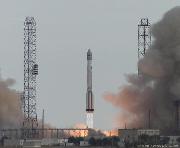Imagine the Universe News - 17 October 2002
Europe opens a window onto a violent Universe
| 17 October 2002 |
|
On 17 October 2002, the European Space Agency launched a new observatory set to revolutionize the branch of astrophysics that seeks to unravel the secrets of the highest-energy, and therefore the most violent, phenomena in the Universe. This comes 20 years after the end of ESA's COS-B mission, which produced a complete map of the sky in the high-energy gamma-ray waveband.
As part of ESA's cooperation with Russia, a Russian Proton launcher was chosen to place the Integral (INTErnational Gamma-Ray Astrophysics Laboratory) observatory in orbit. The launcher lifted off from Baikonur in Kazakhstan today at 10:41 local time. After re-ignition of its upper stage, it placed Integral in its 72-hour elliptical orbit, ranging from only 10000 km up to 153000 km from the Earth, i.e. nearly half the distance to the Moon. Controlled by ESA's ESOC mission operations center in Darmstadt in Germany, the satellite will now undergo a two-months test period intended first to verify that the instruments onboard are working correctly and then that the data they collect is of good quality.Integral was developed by Italy's Alenia Spazio supported by over 30 firms in Europe. The satellite (with a mass of 4000 kg, and a height 5 meters) has two main instruments: the SPI spectrometer and IBIS imager
Developed by a Franco-German-led team, the SPI spectrometer will conduct a spectral analysis of isolated sources and of regions of gamma-ray activity with unprecedented energy resolution (40 times better than previous satellites), using germanium detectors cooled to 85 K. Since mirrors and lenses are of no use in detecting gamma rays, the SPI uses the "coded-mask imaging" technique to form its images from very faint radiation. These images are then decoded by computer.
The IBIS imager, designed by an Italian-led team, is the perfect partner for SPI. It has a weaker energy resolution, but an angular resolution 12 times sharper thanks to a coded mask optimized for the purpose and two new-generation detector layers.
To supplement the observations by SPI and IBIS, Integral also carries a Danish X-ray imager (JEM-X), with twin detectors each fitted with coded masks, and a Spanish CCD imager (OMC) operating in the visible spectrum waveband.
By combining the data collected by these four instruments, it will be possible, for the first time, to make simultaneous observations of high-energy phenomena at seven orders of magnitude, from visible light to gamma rays. All the raw data collected by Integral will be sent directly to the ground via the ESA station at Redu in Belgium, or the station operated by NASA, another partner in the program, at Goldstone in the USA. The raw data will be centralized at ESOC in order to be processed and redistributed to the scientific community via the Integral Scientific Data Centre (ISDC) at Versoix in Switzerland.
 |
| Artist's impression of the Integral spacecraft Integral's four instruments provide, for the first time, simultaneous observations with the same satellite at visible, X-ray and gamma-ray wavelengths for some of the most energetic objects in the Universe. (Credit: ESA) |
Operating in an orbit that enables it to spend most of its time outside the Van Allen radiation belts, which can hamper observation of cosmic gamma rays, Integral will primarily study the densest sky objects, such as neutron stars and black holes, which are all sources of very high energy radiation. While IBIS will supply very detailed images of these sources, SPI will conduct the first in-depth analysis of this gamma radiation. Integral's observations should enable astrophysicists to confirm the presence of giant black holes at the center of galaxies, starting with the Milky Way.
Other areas of interest for the European gamma-ray observatory will include events of rare violence such as nova and supernova explosions. These will be explored with precision thanks to the gamma radiation given off by the radioactive isotopes emitted. Integral will also be a unique means for observing gamma bursts, these still largely unexplained explosions at the outer reaches of the Universe, which for the first time can be studied in parallel along a wide range of the electromagnetic spectrum.
Integral is the second medium-size mission carried out under the Horizon 2000 program, following the Huygens probe, whose destination is Saturn and its moon Titan; the third will be the Planck observatory, which will study the background noise of the Universe, as from 2007. The Integral mission should last at least two years.


